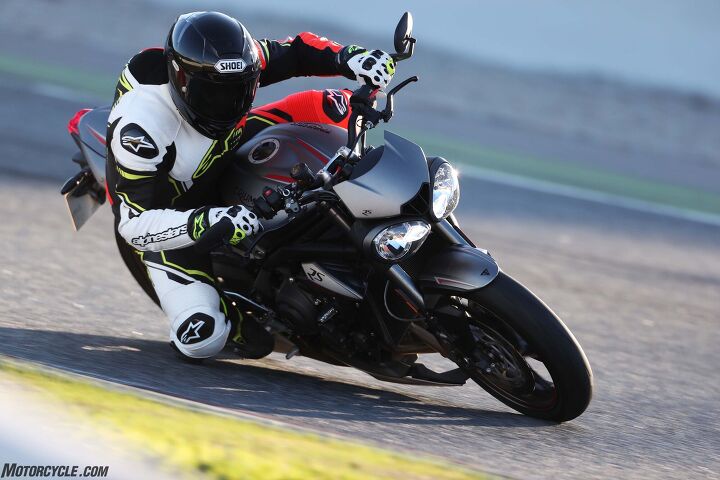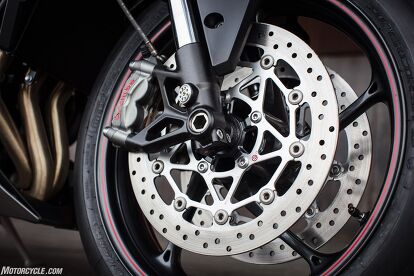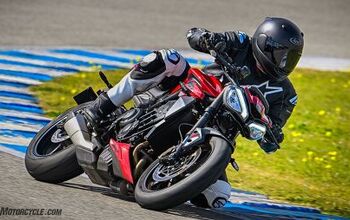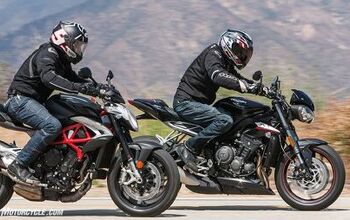2017 Triumph Street Triple RS Review: First Ride
Our first ride aboard Triumph's newest naked
The last time Triumph conducted a major revamp of its Street Triple family was 2013. At that press launch Triumph didn’t feel it necessary to include any track time because even the uptown R model remained predominantly a street bike. Four years on and Triumph has reshuffled the Street Triple deck and expanded the portfolio to three models (S, R, RS), each with a specific focus including the new performance leader RS model we just finished testing in Spain. While still largely a street bike, the RS features enough go-fast performance Triumph felt compelled to showcase the bike’s wherewithal around one of the most famous Spanish racetracks, Catalunya.
2017 Triumph Street Triple RS
| Engine | 19.5/20 |
| Suspension/Handling | 14.0/15 |
| Transmission/Clutch | 8.75 /10 |
| Brakes | 9.5/10 |
| Instruments/Controls | 5.0/5 |
| Ergonomics/Comfort | 9.0/10 |
| Appearance/Quality | 9.5/10 |
| Desirability | 9.5/10 |
| Value | 8.75/10 |
| Overall Score | 93.5/100 |
While the 2013 Street Triple R was a substantial uptick to the original ’09 model, it maintained the same 675cc inline-Triple of the previous year’s bike. Not so at all with the 2017 incarnation. You’re probably aware Triumph bumped displacement of the new version 90cc, from 675cc to 765cc. What we learned from Triumph engineers in Spain, however, is the new mill was developed from the existing Daytona engine, not the previous year’s Street Triple engine.
The result is a more powerful three-cylinder with a claimed 16% increase in peak horsepower and a 13% increase in peak torque for the RS compared to last year’s R model. By the numbers, Triumph claims the base model S to output 111 hp at 11,250 rpm and 54 lb.-ft. at 9,100 rpm, the R model to output 116 hp at 12,000 rpm and 57 lb.-ft. at 9,400 rpm, and 121 hp at 11,700 rpm and 57 lb.-ft. at 10,800 rpm for the RS. Note that the R and RS produce the same amount of torque with the R model peaking 1,400 rpm earlier than the RS. This is due to a different camshaft in the R model, and is an example of the individual character Triumph baked in to each bike, with the R emphasizing streetable, mid-range engine performance compared to the higher-revving nature of the RS.
More For Less: $8K Four Vs. $8.2K Triple Vs. $8.7K Twin
Having only spent time aboard the RS, no honest comparison can yet be made between the S, R, and RS models, nor how each is characterized by its design parameters. What is known is that the engine in the RS performed flawlessly during testing on the street as well as on the track. The linear power delivery we liked so much about the previous 675cc engine was made better by the 90cc bump in displacement. The RS delivering a little extra emphasis when twisting the throttle while maintaining a mid-displacement fun zone without treading into the ridiculously fast atmosphere of Tuonos or Super Duke Rs.
Accompanying the Street Triple’s new engine is a Continental electronics package including ride-by-wire throttle, ride modes (see chart), switchable ABS, switchable Triumph Traction Control, and self-cancelling turn signals. The R and RS both enjoy a slip and assist clutch, while the RS is also endowed with a quick-shifter. None of the models, however, offer cruise control which, on a bike where complaints are few and far between, seems like an oversight.
Ride Modes | Throttle Map | ABS | Traction Control | Available On | ||
S | R | RS | ||||
Rain | Rain | Road | Rain | X | X | X |
Road | Road | Road | Road | X | X | X |
Sport | Sport | Road | Sport | X | X | |
Track | Sport | Track | Track | X | ||
Rider | Rain Road Sport | Road Track Off | Rain Road Sport Track Off | X | X | |
Tied to each ride mode are default settings for throttle mapping (Rain, Road, Sport), ABS (Road, Track, Off), and TTC (Rain, Road, Sport, Track, Off). There is some limited adjustability within the default selections of each ride mode, but only the R and RS models come with full customization in the Rider mode, which is also the mode allowing ABS and TTC to be turned off. Toggling through and selecting ride modes is accomplished on the fly via a five-way joystick on the left handlebar (Track mode requires the bike to be stopped). On the R and RS models, bike information is delivered through a full-color TFT display.
The five-inch display is one of the best we’ve seen yet, with an assortment of styles to choose from to suit personal preferences or riding conditions. Its functionality is intuitive and easy to navigate, while information is legible and smartly configured. The S model receives an updated version of the LCD instrument cluster and analog tach seen on the previous model.
The Four-Thirds Shootout: Tre Cool
Further differences among the models are found in the braking and suspension departments, with the RS boasting four-piston Brembo M50 front brake calipers, a fully adjustable Öhlins STX40 monoshock and fully adjustable 41mm inverted Showa big piston fork. The R model comes equipped four-piston Brembo M432 front brake calipers, fully adjustable Showa monoshock, and 41mm inverted separate-function Showa big piston fork, while the S model has two-piston Nissin front brake calipers, 41mm inverted non-adjustable Showa separate function fork and Showa RSU shock with preload adjustment.
When it comes to braking performance on the RS, what needs to be said? Brembo M50s are still the best in the business regardless to which bike they’re affixed. Powerful without being abrupt, easily modulated at either street or track speeds; until something better comes along the M50s will continue to dominate.
The street portion of our ride began with inclement weather, keeping aggression level low, but with stock setting in place for both front and rear suspension units the Showa fork and Öhlins shock delivered a compliant ride. For the track, Triumph engineers stiffened front and rear settings to deal with the higher speeds, leaving me wanting for nothing, and feeling comfortable through every bend of the 16-turn Catalunya circuit.
Other niceties abound on the Street Triple RS, such as a new gullwing swingarm, revised exhaust system, lower chain guard, bar-end mirrors, a color-matched belly pan and seat cowl. The front brake lever is adjustable not only laterally to the handlebar, but also longitudinally.
Of course you’re going to pay a little extra for the all the fringe benefits the RS carries. The price for the RS begins at $12,500 (a $1,300 increase over the outgoing 2016 RX model), whereas the R model starts at $11,200 (a $900 increase over the 2016 R model), and the S model at $9,900 (a $500 increase over the 2016 S model).
We already had a love affair with the outgoing Street Triple model – enough to award the Street Triple R our 2009 Bike of the Year trophy – and this newest version has improved in nearly every way possible: engine, suspension, brakes, weight and electronics.
At $12,500, the RS certainly costs more than a Yamaha FZ-09, upgraded for 2017 and being ridden and tested by our Evans Brasfield this week. If you’re cross-shopping, it would be better to compare the $9k Yammie to the base model Street Triple with just a $900 difference in MSRPs. A more appropriate match-up for the Street Triple RS would be MV Agusta’s Brutale 800 that lists for $13,498.
Give us a little time and we’ll gladly compare them for you. Mid-displacement three-cylinder shootout, stay tuned.
2017 Triumph Street Triple RS
+ Highs
- Fast but not furious
- Equally at home on street or track
- An already light bike made a little lighter
– Sighs
- What, no cruise control!?!
- Only two color options
- R model’s red subframe looks more high-spec than RS’s silver subframe
2017 Triumph Street Triple RS Specifications | |
|---|---|
| MSRP | $12,500 |
| Horsepower | 121 hp @ 11,700 |
| Torque | 57 lb.-ft. @ 10,800 rpm |
| Engine Capacity | 765cc |
| Engine Type | Inline-Triple |
| Bore x Stroke | 78 x 53.4mm |
| Compression | 12.65:1 |
| Fuel System | EFI |
| Transmission | 6-Speed |
| Clutch | Wet, multi-plate, slip and assist clutch |
| Final Drive | Chain |
| Frame | Aluminium beam twin spar |
| Front Suspension | Showa 41mm upside down big piston forks (BPF), 115mm front wheel travel. Adjustable compression damping, rebound damping and preload. |
| Rear Suspension | Öhlins STX40 piggyback reservoir monoshock, 131mm rear wheel travel. Adjustable spring preload (lock-rings), compression damping and rebound damping. |
| Front Brakes | Twin 310mm floating discs, Brembo M50 4-piston radial monoblock calipers |
| Rear Brakes | Single 220mm fixed disc, Brembo single piston sliding caliper |
| Front Tire | 120/70 ZR17 |
| Rear Tire | 180/55 ZR17 |
| Seat Height | 32.5 in. |
| Wheelbase | 55.5 in. |
| Rake/Trail | 23.9º/3.9 in. |
| Dry Weight (claimed) | 366 lbs. |
| Fuel Capacity | 4.6 gal. |
| Electronics | Ride modes, R-b-W, ABS, TTC, quick-shifter |
| Colors | Matt Silver Ice or Phantom Black (Metallic) |
A former Motorcycle.com staffer who has gone on to greener pastures, Tom Roderick still can't get the motorcycle bug out of his system. And honestly, we still miss having him around. Tom is now a regular freelance writer and tester for Motorcycle.com when his schedule allows, and his experience, riding ability, writing talent, and quick wit are still a joy to have – even if we don't get to experience it as much as we used to.
More by Tom Roderick



























































Comments
Join the conversation
That dash display is slick as snot. I wish my FJ, or my "I wish I had one" Ducati Supersport had that. The grey LCDs work, but they looks like a handheld video game from the '90's. Is Triumph's display TFT or something else?
I really think this is my favorite motorcycle right now.